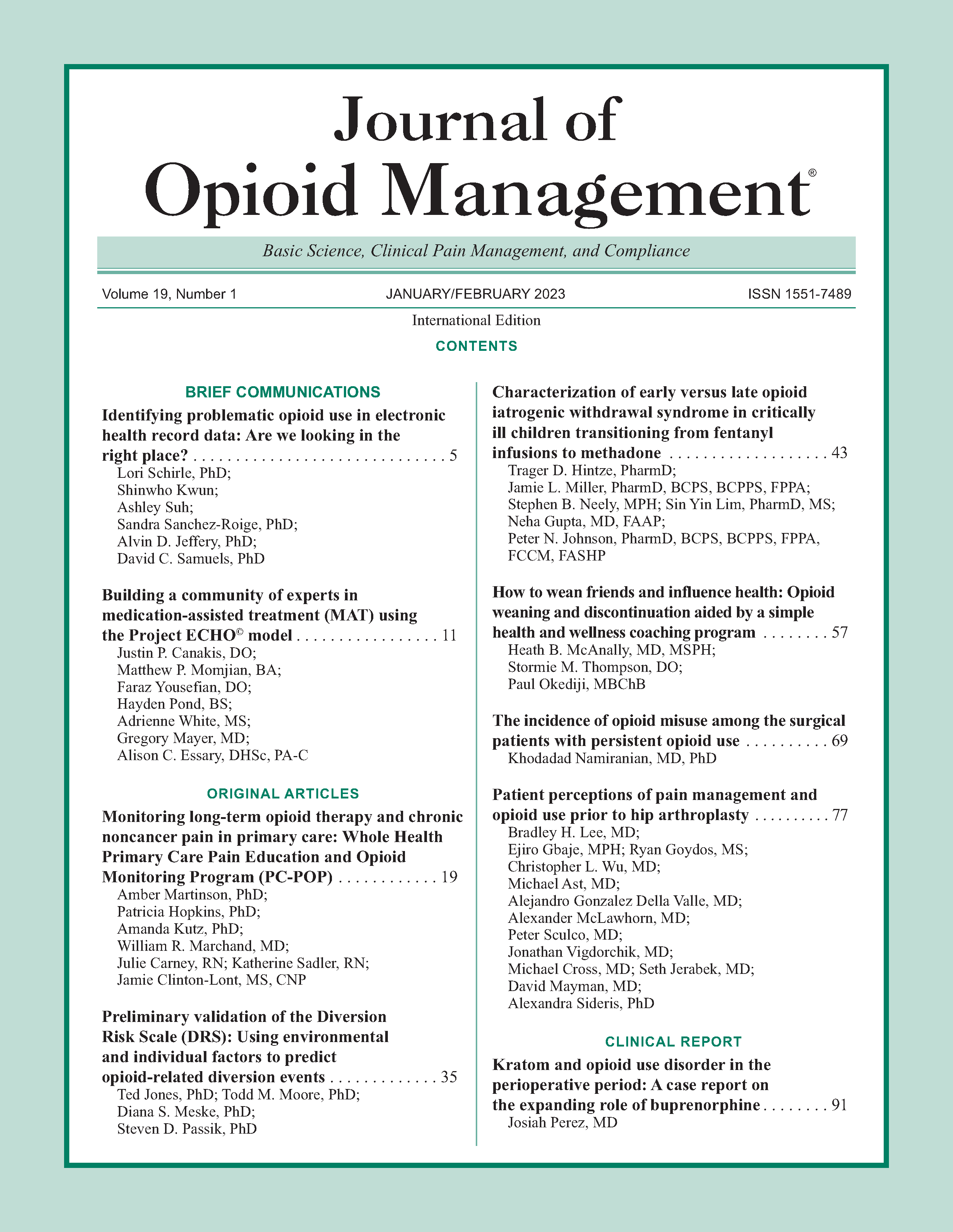Identifying problematic opioid use in electronic health record data: Are we looking in the right place?
DOI:
https://doi.org/10.5055/jom.2023.0754Keywords:
opioid use disorder, electronic health records, patient communications, opioid prescriptions, chronic painAbstract
Objective: To examine the value of data obtained outside of regular healthcare visits (clinical communications) to detect problematic opioid use in electronic health records (EHRs).
Design: A retrospective cohort study.
Participants: Chronic pain patient records in a large academic medical center.
Interventions: We compared evidence for problematic opioid use in (1) clinic notes, (2) clinical communications, and (3) full EHR data. We analyzed keyword counts and calculated concordance and Cohen’s κ between data sources.
Main outcome measure: Evidence of problematic opioid use in EHR defined as none, some, or high.
Results: Twenty-six percent of records were discordant in determination of problematic opioid use between clinical communications and clinic notes. Of these, 54 percent detected more evidence in clinical communications, and 46 percent in clinic notes. Compared to full EHR review, clinic notes exhibited higher concordance (78 percent; κ = 0.619) than clinical communications (60 percent; κ = 0.290).
Conclusion: Clinical communications are a valuable addition to opioid HER research.
References
Imtiaz S, Nafeh F, Russell C, et al.: The impact of the novel coronavirus disease (COVID-19) pandemic on drug overdose-related deaths in the United States and Canada: A systematic review of observational studies and analysis of public health surveillance data. Subst Abuse Treat Prev Policy. 2021; 16(1): 87. DOI: 10.1186/s13011-021-00423-5.
Cowie MR, Blomster JI, Curtis LH, et al.: Electronic health records to facilitate clinical research. Clin Res Cardiol. 2017; 106(1): 1-9. DOI: 10.1007/s00392-016-1025-6.
Ehrenstein V, Kharrazi H, Lehmann H: Obtaining data from electronic health records. In Gliklich RE, Leavy MB, Dreyer NA (eds.): Tools and Technologies for Registry Interoperability, Registries for Evaluating Patient Outcomes: A User’s Guide, 3rd ed. Addendum 2. Rockville, MD: Agency for Healthcare Research and Quality (US), 2019, Chapter 4.
Campbell G, Bruno R, Lintzeris N, et al.: Defining problematic pharmaceutical opioid use among people prescribed opioids for chronic noncancer pain: Do different measures identify the same patients? Pain. 2016; 157(7): 1489-1498. DOI: 10.1097/j.pain.0000000000000548.
Manhapra A, Sullivan MD, Ballantyne JC, et al.: Complex persistent opioid dependence with long-term opioids: A gray area that needs definition, better understanding, treatment guidance, and policy changes. J Gen Intern Med. 2020; 35(Suppl. 3): 964-971.
Bastarache L, Brown JS, Cimino JJ, et al.: Developing real-world evidence from real-world data: Transforming raw data into analytic datasets. Learn Health Syst. 2022; 6(1): e10293. DOI: 10.1002/lrh2.10293.
Kovatch M, Feingold D, Elkana O, et al.: Evaluation and comparison of tools for diagnosing problematic prescription opioid use among chronic pain patients. Int J Methods Psychiatr Res. 2017; 26(4): e1542.
Palmer RE, Carrell DS, Cronkite D, et al.: The prevalence of problem opioid use in patients receiving chronic opioid therapy: Computer-assisted review of electronic health record clinical notes. Pain. 2015; 156(7): 1208-1214.
Sullivan MD, Edlund MJ, Fan MY, et al.: Risks for possible and probable opioid misuse among recipients of chronic opioid therapy in commercial and Medicaid insurance plans: The TROUP study. Pain. 2010; 150(2): 332-339. DOI: 10.1016/j.pain.2010.05.020.
Schirle L, Jeffery A, Yaqoob A, et al.: Two data-driven approaches to identifying the spectrum of problematic opioid use: A pilot study within a chronic pain cohort. Int J Med Inform. 2021; 156: 104621. DOI: 10.1016/j.ijmedinf.2021.104621.
American Psychiatric Association (APA): Diagnostic and Statistical Manual of Mental Disorders, Fifth Edition DSM-5. 5th ed. Washington, DC: American Psychiatric Association, 2013.
Ballantyne JC, Sullivan MD, Kolodny A: Opioid dependence vs addiction: A distinction without a difference? Arch Intern Med. 2012; 172(17): 1342-1343. DOI: 10.1001/archinternmed.2012.3212.
Kimmel SD, Rosenmoss S, Bearnot B, et al.: Rejection of patients with opioid use disorder referred for post-acute medical care before and after an anti-discrimination settlement in Massachusetts. J Addict Med. 2021; 15(1): 20-26. DOI: 10.1097/ADM.0000000000000693.
Substance Abuse and Mental Health Services Administration (SAMSA): Prevention programs and policies. In Office of the Surgeon General. Facing Addiction in America: The Surgeon General’s Report on Alcohol, Drugs, and Health. Washington, DC: US Department of Health and Human Services, 2016: Chapter 3. Available at https://addiction.surgeongeneral.gov/. Accessed June 27, 2022.
Published
How to Cite
Issue
Section
License
Copyright 2005-2025, Weston Medical Publishing, LLC and Journal of Opioid Management. All Rights Reserved.











